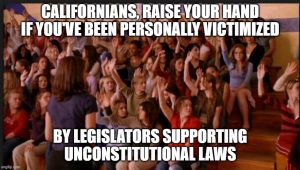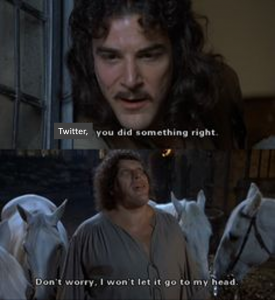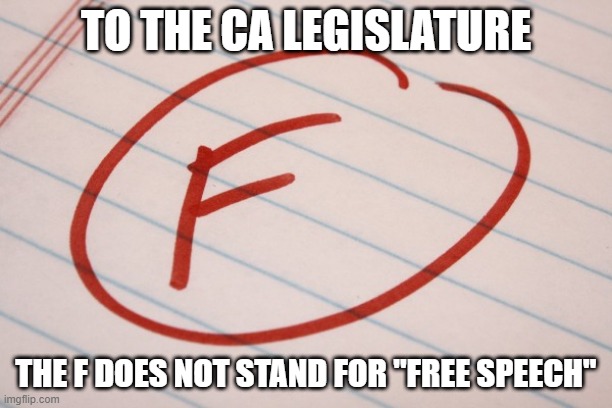Ninth Circuit Enjoins Much of California’s Mandatory Editorial Transparency Law (AB 587)–X v. Bonta
 In 2022, the California legislature went on a censorship bender (which it’s still on). Its 2022 class of online censorship laws included the California Age-Appropriate Design Code (largely declared unconstitutional in NetChoice v. Bonta) and AB 587, an editorial transparency law. The California legislature was repeatedly warned that those laws were unconstitutional (my last-ditch warning re AB 587), and legislators responded with their standard hubris, e.g., “Bring it!” and “I’ll wear the censorship challenge in court as a badge of honor!”
In 2022, the California legislature went on a censorship bender (which it’s still on). Its 2022 class of online censorship laws included the California Age-Appropriate Design Code (largely declared unconstitutional in NetChoice v. Bonta) and AB 587, an editorial transparency law. The California legislature was repeatedly warned that those laws were unconstitutional (my last-ditch warning re AB 587), and legislators responded with their standard hubris, e.g., “Bring it!” and “I’ll wear the censorship challenge in court as a badge of honor!”
Well, the grades for the 2022 California legislature are coming in from the courts, and guess what? They are getting an F for free speech.
* * *
The Law
California AB 587 requires big UGC publishers to post TOSes that meet various specifications and to publish highly detailed and specific disclosures and statistics about their editorial operations and decisions, principally organized along six topical categories:
(A) Hate speech or racism
(B) Extremism or radicalization
(C) Disinformation or misinformation
(D) Harassment
(E) Foreign political interference
(F) Controlled substance distribution
The court calls the latter disclosures the “Content Category Report.”
By my calculation, the law initially created a matrix of no less than 161 different required disclosures. Since then, the legislature amended the law to add the “Controlled substance distribution” category of disclosures, which further increased the disclosure quantity.
X facially challenged the TOS disclosures and the statistics and editorial operations disclosures. The district court denied the preliminary injunction. X only appealed the denial with respect to the statistics and editorial options disclosures, and the Ninth Circuit reverses on that ground. That leaves the TOS disclosures obligation unenjoined, but the California AG should tread cautiously there because I think it also has serious constitutional defects.
The Court Opinion
Facial Challenge. The court says:
all aspects of the Content Category Report, in every application to a covered social media company, raise the same First Amendment issues….every Content Category Report must detail the company’s policies and actions concerning certain state-specified categories of content (even if only to detail the company’s decision not to define the enumerated categories of section 22677(a)(3)). In effect, the Content Category Report provisions compel every covered social media company to reveal its policy opinion about contentious issues, such as what constitutes hate speech or misinformation and whether to moderate such expression
Compelled Non-Commercial Speech. The Supreme Court is increasingly signaling that all compelled corporate speech should be treated as “commercial speech,” which becomes the foundation for applying the undertheorized and lightweight Zauderer standard.
This court takes a different path, saying bluntly that “the Content Category Reports are not commercial speech.” The court explains that the reports “require a company to recast its content-moderation practices in language prescribed by the State, implicitly opining on whether and how certain controversial categories of content should be moderated.”
The court supports its conclusion that the Content Category Reports obligation generates non-commercial speech by riffing on Bolger:
- the reports don’t propose a commercial transaction
- the reports “express a view about [the publisher’s commercial] terms by conveying whether a company believes certain categories should be defined and proscribed.” The court seems to be saying that compelling a company to speak about whether content categories should be defined and proscribed invades their rights not to speak on those topics.
- the reports aren’t “advertisements” (whatever that means as a contraposition to “commercial speech”)
- “a social media company has no economic motivation in the [report’s] content”
The latter point exposes the vulnerability of this ruling. All corporate disclosures can have economic impacts if consumers use the information to decide whether or not to transact. For that reason, if the company not providing consumers more guidance on the verboten content categories could be considered a deceptive omission, that might make other disclosures false advertising. This is how courts reach overexpansive applications of Zauderer and uphold many compelled commercial disclosures. In contrast, I think the real problem with AB 587 and similar laws is that the compelled disclosures are being imposed on editorial publishers, and forcing publishers to answer these mandated questions has unavoidable and censorial effects on their editorial choices and speech. Because this court plays around with the definition of “commercial” speech instead of hitting the more critical point about distorting editorial choices, the opinion leaves some rough edges that other courts might smooth out.
This court expressly addresses the speech effects of the compelled editorial transparency, so it’s unfortunate it didn’t rely more heavily on those and instead adopted a more difficult-to-defend legal solution (the non-commercial speech characterization):
The Content Category Report provisions would require a social media company to convey the company’s policy views on intensely debated and politically fraught topics, including hate speech, racism, misinformation, and radicalization, and also convey how the company has applied its policies….
Insight into whether a social media company considers, for example, (1) a post citing rhetoric from on-campus protests to constitute hate speech; (2) reports about a seized laptop to constitute foreign political interference; or (3) posts about election fraud to constitute misinformation is sensitive, constitutionally protected speech that the State could not otherwise compel a social media company to disclose without satisfying strict scrutiny. The mere fact that those beliefs are memorialized in the company’s content moderation policy does not, by itself, convert expression about those beliefs into commercial speech.
The court summarizes that the compelled disclosures are content-based, so they are subject to strict scrutiny. The court doesn’t cite the Volokh v. James opinion (on appeal to the Second Circuit), which also applied strict scrutiny to a mandatory editorial transparency law.
 Scrutiny Analysis. The court says the disclosure obligation isn’t narrowly tailored. Instead, the state court require publishers to disclose “whether it was moderating certain categories of speech without having to define those categories in a public report. Or, perhaps, a company could be compelled to disclose a sample of posts that have been removed without requiring the company to explain why or on what grounds.” What? The court goes out of its way to identify alternative legislative solutions that it acknowledges might also be unconstitutional, in which case those aren’t really alternatives, are they?
Scrutiny Analysis. The court says the disclosure obligation isn’t narrowly tailored. Instead, the state court require publishers to disclose “whether it was moderating certain categories of speech without having to define those categories in a public report. Or, perhaps, a company could be compelled to disclose a sample of posts that have been removed without requiring the company to explain why or on what grounds.” What? The court goes out of its way to identify alternative legislative solutions that it acknowledges might also be unconstitutional, in which case those aren’t really alternatives, are they?
In any case, the compelled Content Category Reports fail strict scrutiny. The court sends the case back to the lower court to determine severability for the rest of the la.
Implications
Legislators ♥ Censorship. In my explainer about AB 587, I told the California legislature:
The bill is likely to be struck down as unconstitutional at substantial taxpayer expense. The censorial consequences should trigger the highest level of constitutional scrutiny, but the undue burdens and lack of consumer benefit ensures it won’t survive even lower levels of scrutiny.
This prediction (and similar warnings from other savvy folks) had no effect. Instead, the CA legislature DOUBLED-DOWN on the law the next legislative session to make it MORE censorial.
After seeing their efforts fail in court, you might think that the legislators responsible for this unconstitutional law would be apologizing to their constituents and vowing to reform their censorial ways. Nope. Legislatures are still on their censorship bender.
The Zauderer Problem. The law of compelled commercial speech is a jurisprudential mess. This court sidesteps that mess by saying that the law compels non-commercial speech, but that conclusion diverges from the Supreme Court trends. This doctrinal splintering reflects the flaws in the Zauderer standard, which was undertheorized and underexplained when the Supreme Court first adopted it and has predictably spurred an inconsistent and untethered jurisprudence due to that initial weakness. The Supreme Court desperately needs to fix the Zauderer problems it created; until then, we will keep seeing zany lower court opinions going in different directions.
This panel might have more closely engaged with the Moody opinion’s discussion of editorial transparency, as brief and cryptic as it was. Articulating a mutant version of Zauderer, the Moody majority said that courts should review “whether the required disclosures unduly burden expression.” This court didn’t do that. Addressing the burdens on expression would have made sense as a backup analysis if the court wanted to harden this opinion for possible appeal.
The court does gesture at the law’s speech effects, basically indicating that it forces them to take a position on topics they may wish to avoid. That’s an OK conclusion, but in my mind that misdirects from the real way the law burdens speech, by pushing publishers to change their editorial standards on the content categories targeted by the law. Other rationales for striking down the law will inevitably feel a little hollow in comparison. As I articulate in my Zauderer piece, the Content Category Reports clearly unduly burden publishers, starting with the fact that it initially required 161 disclosures.
Where Does This Leave Other Mandatory Editorial Disclosures? It’s hard to predict how this ruling will apply to other mandatory editorial transparency laws, including the TOS disclosures that weren’t addressed in this ruling. In a sense, all editorial transparency mandates force editorial publishers to speak on topics they don’t want to address, and typically those disclosures won’t be “commercial speech” any more than the disclosures here. However, because the court sidestepped the Moody standard and also didn’t address the effects of distorting editorial judgments, the opinion leaves room for courts to navigate around this ruling.
 Twitter Did a Public Service. Twitter in the Musk era has been wildly inconsistent regarding free speech. Here, they did something right. Other major Internet services were apparently planning to acquiesce to this law and try to comply, rather than challenge it in court. Their apathy would have let legislative hubris and litigation fatigue produce an unconstitutional outcome. Twitter broke ranks to bring this much-needed challenge–and in doing so, created an outcome that benefits the industry (breaking up this law) while bearing the costs privately. (This is a common public goods problem of impact litigation). For making the courageous and expensive decision in the face of widespread industry apathy, Twitter gets a gold star for this decision. (I still have other beefs with Twitter, and their good decision here doesn’t cure those concerns).
Twitter Did a Public Service. Twitter in the Musk era has been wildly inconsistent regarding free speech. Here, they did something right. Other major Internet services were apparently planning to acquiesce to this law and try to comply, rather than challenge it in court. Their apathy would have let legislative hubris and litigation fatigue produce an unconstitutional outcome. Twitter broke ranks to bring this much-needed challenge–and in doing so, created an outcome that benefits the industry (breaking up this law) while bearing the costs privately. (This is a common public goods problem of impact litigation). For making the courageous and expensive decision in the face of widespread industry apathy, Twitter gets a gold star for this decision. (I still have other beefs with Twitter, and their good decision here doesn’t cure those concerns).
Case Citation: X Corp. v. Bonta, 2024 WL 4033063 (9th Cir. Sept. 4, 2024)
Selected Posts on Compelled Editorial Transparency
- My Amicus Brief in Moody v. NetChoice and NetChoice v. Paxton
- I Filed an Amicus Brief Against New York’s Editorial Transparency Law
- New York’s Mandatory Editorial Transparency Law Preliminarily Enjoined–Volokh v. James
- Rounding Up Some Recent Editorial Transparency Developments
- My New Article Drops a Truth Bomb on Zauderer and Censorial Efforts to Mandate Editorial Transparency
- The 5th Circuit Puts the 1st Amendment in a Blender & Whips Up a Terrible #MAGA Kool-Aid–NetChoice v. Paxton
- A Short Explainer of Why California’s Mandatory Transparency Bill (AB 587) Is Terrible
- Quick Links from the Past Year, Part 8 (Editorial Transparency)
- Will California Clone-and-Revise Some Terrible Ideas from Florida/Texas’ Social Media Censorship Laws? (Analysis of CA AB587)
- My SCOTUS Amicus Brief on Texas HB20’s Unconstitutional Transparency Requirements
- New Article: “The Constitutionality of Mandating Editorial Transparency”
Articles:

